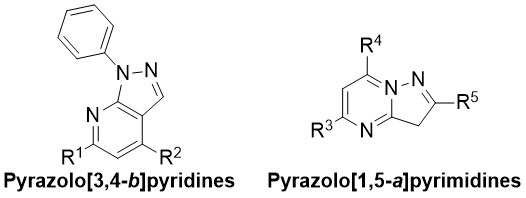Heterocyclic compounds for biological applications
Heterocyclic chemistry is a broad and rapidly growing branch of organic chemistry that has been of interest to much of the scientific community for many years. This stems from the fact that heterocyclic compounds have applications in many branches of chemistry, such as medicinal chemistry. Our laboratory has been involved in the economical, efficient, and environmentally friendly synthesis of small libraries of novel heterocyclic molecules with various therapeutic targets. Our interest is focused on the synthesis of pyrazolopyridines, pyrazolopyrimidines and other N-containing heterocyclic systems.
For example, pyrazolo[3,4-b]pyridines constitute a group of fused heterocyclic systems with outstanding chemical, biological and medicinal significance. This privileged scaffold is also the main structural component of clinically used drugs against AD. To this end, a small library of pyrazolo[3,4-b]pyridines was prepared in a two-step procedure by using simple reagents. Exciting absorption and fluorescence properties were recorded for the new compounds, also evaluated for selective binding to amyloid plaques with encouraging results.1 The activity of these molecules in other biological targets is also being investigated. Two post graduate (MSc) students have been involved in the design and synthetic part of the current research activity, which is implemented in our laboratory under the supervision of Dr V. Vidali in collaboration with the Institute of Biosciences & Applications at NCSR "Demokritos" (Dr M. Sagnou).

Figure 1. Pyrazolo[3,4-b]pyridines and pyrazolo[1,5-a]pyrimidines.
Pyrazolo[1,5-a]pyrimidines have also been synthesized, and their inhibiting properties on the MYC-MAX dimerization are investigated. Inhibition of the specific protein is crucial for developing therapeutic methods against cancer because of its significant impact on the development of cancer cells, such as those of pancreatic adenocarcinoma and other cancers. The research uses heterocyclic molecules as lead compounds modified appropriately, varying their substituents, adding different groups, or even changing the central heterocyclic core. The above variations are based on computer-aided design aiming to optimize their properties. The novel compounds are investigated in cell-free, in vitro and in vivo assays.2 This research is ongoing in collaboration with the Biomedical Research Foundation, Academy of Athens and the University of Ioannina as part of the research grant entitled: "Development of novel anticancer drugs with therapeutic target the oncoprotein MYC" (MIS-5031813) funded by the Operational Program Competitiveness, Entrepreneurship and Innovation (NSRF2014-2020) co-financed by Greece and the European Community.
References
- (a) G. Nigianni, Master's thesis:"’Synthesis of monocarbonyl derivatives of curcumin and study of their biological activity as inhibitors of the aggregation of Ab- amyloid peptide of Alzheimer’s disease.", Postgraduate program "Medicinal Chemistry & Chemical Biology", Departments of Chemistry and Medicine, Schools of Natural and Health Sciences, University of Patras, Patras, Greece, 2020.; (b) “Synthesis of novel pyrazolopyridines with affinity of B-amyloid plaques and fibrils”, V. P. Vidali, G. Nigianni, G. D. Athanassopoulou, A. Canko, V. Mavroidi, D. Matiadis, M. Pelecanou, M. Sagnou, 18th Hellenic Symposium on Medicinal Chemistry (HSMC-18) (February, 2020).
- "Abstract LB-262: Design, synthesis, and efficacy of MYC inhibitors in mouse pancreatic cancer". V. P. Vidali, Z. Cournia, A. Papadimitropoulou, D. Stellas, A. Klinakis, E. A. Couladouros, C. Tamvakopoulos, A. Efstratiadis, July 2018, Cancer Research 78(13 Supplement):LB-262-LB-262, April 14-18, 2018, Chicago, Illinois, USA, DOI: 10.1158/1538-7445.AM2018-LB-262.